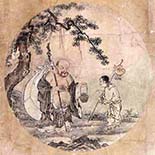 Ten Bulls or Ten Ox Herding Pictures, is a series of short poems and accompanying drawings used in the Zen tradition to describe the stages of a practitioner’s progress toward enlightenment, and their return to society to enact wisdom and compassion.
Ten Bulls or Ten Ox Herding Pictures, is a series of short poems and accompanying drawings used in the Zen tradition to describe the stages of a practitioner’s progress toward enlightenment, and their return to society to enact wisdom and compassion.
The best known version of the oxherding pictures was drawn by the 12th century Chinese Rinzai Chán (Zen) master Kuòān Shīyuǎn (Jp. Kaku-an Shi-en), who also wrote accompanying poems and introductory words attached to the pictures. In Kuòān Shīyuǎn’s version, there is no whitening process, and his series also doesn’t end with mere emptiness, or absolute truth, but shows a return to the world, depicting Putai, the laughing Buddha. In Japan, Kuòān Shīyuǎn’s version gained a wide circulation, the earliest one probably belonging to the fifteenth century.
The ox-herding pictures had an immediate and extensive influence on the Chinese practice of Chan Buddhism. According to Chi Kwang Sunim, they may represent a Zen Buddhist interpretation of the ten Bodhisattva bhumi, the ten stages on the Bodhisattva-path.
The pictures first became widely known in the West after their inclusion in the 1957 book, Zen Flesh, Zen Bones: A Collection of Zen and Pre-Zen Writings, by Paul Reps and Nyogen Senzaki. Alan Watts included a description of the Ten Bulls in The Spirit of Zen. The pictures went on to influence the work of John Cage, particularly in his emphasis on rhythmic silence, and on images of nothingness. The pictures, especially the last one (‘In the Marketplace’), have provided a conceptual umbrella for those Buddhists seeking a greater engagement with the post-industrial global marketplace.
Cat Stevens’ sixth studio album Catch Bull at Four is a reference to the 4th step towards enlightenment. On the album, the song Sitting refers to meditation, and the apprehensions that may result from the experiences resulting from enlightenment. Catch Bull at Four was commercially successful and spent 3 weeks at number one in the Billboard album charts in 1972.
In the 1989 South Korean film Why Has Bodhi-Dharma Left for the East?, an ox escapes into the forest and one of the protagonists, a young boy, attempts to hunt it down through the bushes. During the opening scene of Apichatpong Weerasethakul’s 2010 film Uncle Boonmee Who Can Recall His Past Lives, a water buffalo stands tied to a tree before breaking loose and wandering into a forest.
1. In Search of the Bull
In the pasture of the world,
I endlessly push aside the tall
grasses in search of the Ox.
Following unnamed rivers,
lost upon the interpenetrating
paths of distant mountains,
My strength failing and my vitality exhausted, I cannot find the Ox.
2. Discovery of the Footprints
Along the riverbank under the trees,
I discover footprints.
Even under the fragrant grass,
I see his prints.
Deep in remote mountains they are found.
These traces can no more be hidden
than one’s nose, looking heavenward.
3. Perceiving the Bull
I hear the song of the nightingale.
The sun is warm, the wind is mild,
willows are green along the shore –
Here no Ox can hide!
What artist can draw that massive head,
those majestic horns?
4. Catching the Bull
I seize him with a terrific struggle.
His great will and power
are inexhaustible.
He charges to the high plateau
far above the cloud-mists,
Or in an impenetrable ravine he stands.
5. Taming the Bull
The whip and rope are necessary,
Else he might stray off down
some dusty road.
Being well-trained, he becomes
naturally gentle.
Then, unfettered, he obeys his master.
6. Riding the Bull Home
Mounting the Ox, slowly
I return homeward.
The voice of my flute intones
through the evening.
Measuring with hand-beats
the pulsating harmony,
I direct the endless rhythm.
Whoever hears this melody
will join me.
7. The Bull Transcended
Astride the Ox, I reach home.
I am serene. The Ox too can rest.
The dawn has come. In blissful repose,
Within my thatched dwelling
I have abandoned the whip and ropes.
8. Both Bull and Self Transcended
Whip, rope, person, and Ox –
all merge in No Thing.
This heaven is so vast,
no message can stain it.
How may a snowflake exist
in a raging fire.
Here are the footprints of
the Ancestors
9. Reaching the Source
Too many steps have been taken
returning to the root and the source.
Better to have been blind and deaf
from the beginning!
Dwelling in one’s true abode,
unconcerned with and without –
The river flows tranquilly on
and the flowers are red.
10. Return to Society
Barefooted and naked of breast,
I mingle with the people of the world.
My clothes are ragged and dust-laden,
and I am ever blissful.
I use no magic to extend my life;
Now, before me, the dead trees
become alive.